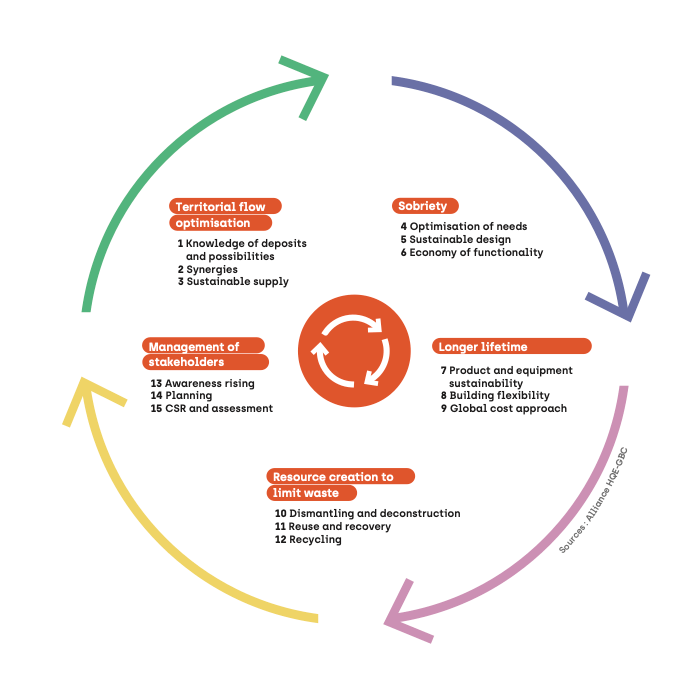Context and challenges
The challenges of developing a circular economy are high. Indeed, buildings, both for their construction and their operation, currently represent 40% of European energy consumption and more than 50% of the raw materials extracted. In France, the building sector generates approximately 42 million tonnes of waste each year, more than households (30 million tonnes) but 4 to 5 times less than public works (185 million tonnes).
The construction sector has been engaged for many years now in a process of reducing its environmental impact. It strives to move from a linear economic model “make, consume, throw away” to a circular model, which will integrate the entire life cycle of products. The 2020 decade marks an important regulatory milestone: Circular Economy Roadmap, anti-waste law for a circular economy adopted in February 2020, free collection of waste from professionals and individuals as soon as they are subject to separate collection from 2022, implementation of an EPR (Extended Producer Responsibility) sector applicable to construction products and materials in 2023.
Definition
Many definitions coexist positioning the circular economy as a lever for sustainable development. Its objective is to reduce the impact on the environment (resources, pollution and waste) and to create value both socially (jobs, lifestyles and consumption) and economically (cooperation and territorial development). The model is based on operating in “short loops”, as opposed to the traditional linear model, which goes from extraction to waste, passing through production and consumption and is based on an unlimited use of resources. In the circular economy model, responsible production and consumption of resources lead to responsible waste management.
Framework for defining the circular economy of the Alliance HQE-GBC
Anticipating the rise of the new “Circular Economy” paradigm, the Alliance HQE-GBC set up a dedicated interprofessional working group in 2017, setting itself the particular objective of writing the framework for defining the circular economy in the building.
This work led to the publication in January 2018 of the framework for defining the circular economy in the building industry, making it possible to share a common vision, vocabulary and tools for the entire construction sector. This framework aims to facilitate cross-functionality and encourage construction players to work together, a sine qua non of the circular economy. It makes the link with the reference framework for sustainable building, the circular economy representing an important component of sustainable development, particularly with regard to the UN’s SDG 12 “Responsible production and consumption”. It is based on a global approach, all ambitions and levers being transversal to the different phases (program, design, site, operation, etc.) of a project.

Action levers
The Alliance HQE-GBC has identified 15 action levers to integrate the principles of the circular economy into buildings, both in new construction and in renovation, included in the “HQE” certifications and highlighted in the “Profile Economie Circular”. Drawing on its knowledge of Life Cycle Analysis (LCA) applied to new buildings and buildings under renovation, the HQE-GBC Alliance used this methodology to develop circularity indicators with a material flow analysis tool ( MFA), built with its partners: EVEA, Cerqual, CSTB, CERTIVEA, INIES and the financial support of ADEME.
The work carried out by the Alliance HQE-GBC on the circular economy
To test the relevance and scientific robustness of the proposed indicators and tools, the HQE-GBC Alliance has launched an HQE Performance “Circular Economy” Test as part of its collaborative innovation program. As part of a market logic, this HQE Performance Test also constitutes an incentive to move into operations. The HQE Circular Economy Performance Test, based on a performance-based approach to the circular economy, is based on five key concepts:
- Territorial optimization of flows
- The sobriety of the work
- Extending the life of the structure
- The creation of resources to limit waste
- Stakeholder management.
The Alliance HQE-GBC also participates in research projects such as the Ovalec project (2015-2018) where it is a member of the consortium with BRGM, Bouygues Construction and the CSTB, or in the Fondation Bâtiment Energie as a user member.